-
Posts
4,286 -
Joined
-
Last visited
Content Type
Profiles
Forums
Gallery
Events
Posts posted by Blue Ensign
-
-
I can see the logic of your argument Daniel but such items are not included by Steel as 'Necessary Ropes' yet he mentions Entering ropes and stern ladders. Although I have seen Jacobs ladders rigged on contemporary models, I've not seen those shroud ladders rigged on British ships at least.
Perhaps British Tars were more agile than you imagine

M.
-
I think you'll find that book very useful Hamilton, loads of clear drawings of fittings as well as rigging, and there are rigging size tables included.
Cheers,
B.E.
-
Looks much better Peter

B.E.
-
Hi Hamilton, the brass etched sets for all their models are available separately, but should be included with the kits to which they relate.
The blurb does make reference to etched brass chainplate assemblies with strops, shroud cleats, trucks, stunsail yard brackets as being with the kit.
If you want to put your mind at rest drop an email to Jokita:-
http://www.jotika-ltd.com/Pages/1024768/Profile.htm#Contact
Cheers,
B.E.
-
Nice progress Peter, a good idea about the boomkins, they won't be needed until you rig the Fore tacks.
Regards,
B.E.
-
Hi B.E.,
Thanks very much! My name's actually Robert -- but hopefully you still meant your encouragement for me

Cheers,
Robert
Sorry Robert, a senior moment, I knew who I meant.... I think

Yes it surely was you.

B.E.
-
Great close-up shots of your deck planking Jason, love your work on the hooded planks and scarphs.
Cheers,
B.E.
-
For those who may not wish to go to the trouble of making their own serving machines there is one available from Shipahoy Models based in Boston USA.
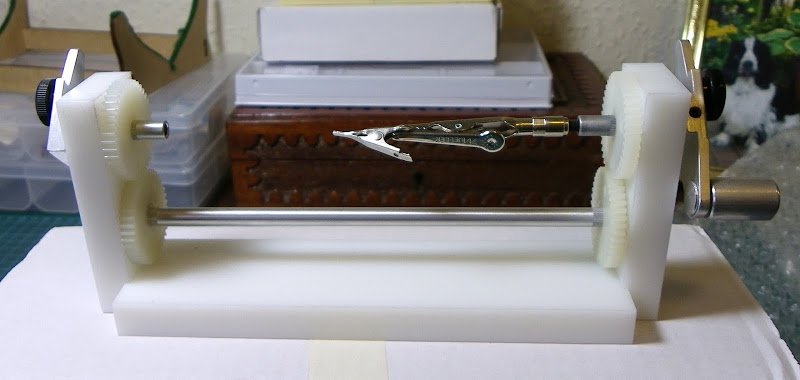
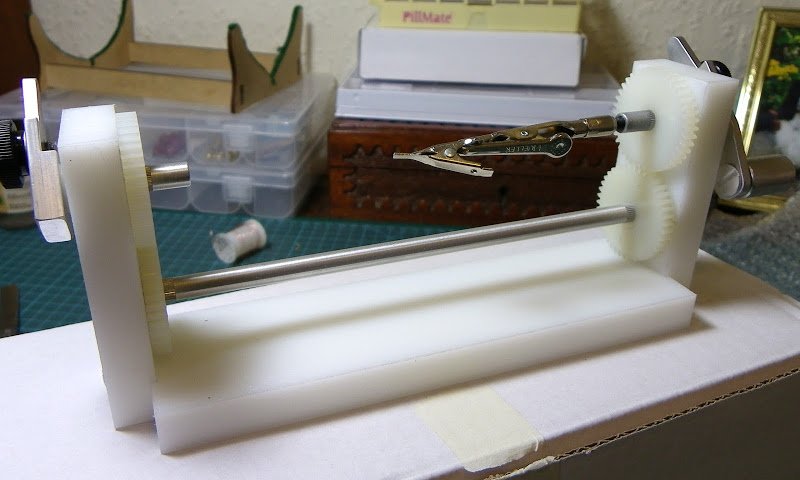
I came across the link on the old MSW. Here are the contact details.
Robert Prezioso shipahoymodels@yahoo.com
B.E.
- janos and sonicmcdude
-
 2
2
-
Hate to say this Dave, but I think you've got the stocks on upside down.

B.E.
-
Hi Martin, how the Euphroe block is attached to its related tackle is also covered by David Antscherl in Volume 1V on page 66 and there is a photo on page 67.
The Euphroe is tensioned on the stay by use of a tackle with two single blocks. The upper block is stropped around the Euphroe, and the lower tackle block is seized to the stay.
The standing part of the tackle falls was made fast to the Upper block; the running part after reeving thro' both blocks was either hitched to the stay below the lower block or made fast around the tackle.
When the lower block is attached to the stay which should be around six scale feet below the mouse (Antscherl) it is a good idea to only temporarily fix it to allow for adjustment of proper tension of the tackle once the crowsfeet have been rigged.
On a ship the size of Pegasus the crowsfeet would be of 3/4" circumference line equivalent to 0.1mm diameter line at scale.
B.E.
-
For my model I wanted to achieve that mellow golden look between the wales that is representative of ‘bright’ sides ie payed with rosin, as seen in many marine paintings contemporary to the period.
After some trialling I decided upon Humbrol Matt Cream (103) as the base coat.
Once dry I coated it with white shellac, which dries very quickly, and then over-painted with mellow pine wood dye.
This may seem a little unorthodox to many model painters, but I obviously tried out the operation on a spare plastic hull before committing to the real thing. I then couldn’t resist fiddling some more with the broadsides, and over-washed with artists oils of ochre toned with raw umber.
I think the same effect would have been achieved using just the Humbol oil paint as the base coat and over washed with artists oils.
What type of paint did you use before applying the oil wash, are you mixing water based and oil based products?
Cheers,
B.E.
-
Hi Pat, I think there was more than a touch of artistic licence taken in portraying some of those below decks scenes, and some of the deck heights are very suspect.
The differences in below deck space between say Victory of 1765, and Warrior of 1860 are quite marked, it's very interesting to do back to back tours of both ships, and see the advances made in living conditions between the two eras.
B.E.
-
-
Hello Mark,
Lees refers to the Breast B/S set up in the usual fashion ie with deadeyes, but considers that very few English ships carried them, basing his view on having found only two contemporary models of ships of 1719 and 1733 fitted with them, and then presumably a model circa 1839 also with them.
Lees differentiates between a Breast b/s and a running breast b/s which is set up with the tackle on the channels.It may be that by the time Steel was writing, breast backstay (with tackles) was the norm as the other form had not been in use for many years and there was no need to specify between the two.
In the AotS book Bellona by Brian lavery he shows 3pr of standing b/s on the Fore topmast and what he also calls a Fore Breast b/s having the tackle and falls set up. He shows on the main topmast in addition to the three pr of standing b/s a shifting b/s, something Lees says were not generally seen. A breast b/s is not shown on the main Topmast.
Longridge writing about rigging his model of Victory decribes three forms of topmast b/s, standing, breast and shifting and he includes all three on his model on the fore and Main topmasts.
Personally if I were rigging Bellona I would include the 3 standing pair, and the breast b/s (with tackles) on both Fore and Main Topmasts.
B.E.
-
That's a nice model Bob, of an unusual subject, well executed, I like the look of her.
B.E.
-
Hi Tony,
Lees gives a good explanation of rigging crowsfeet in his book.
It was a continuous line.
The rope was spliced around the strop of the Euphroe block, its other end reeving thro' the centre hole in the rim of the top from above, up thro' the next hole to port, thro' the upper hole of the Euphroe block, up thro' the inner starboard hole in the top, and so on until the line finally came out of the outer hole on the starboard side of the top. There it was hitched to the underpart of the previous lead thro' the top.
B.E.
-
That particular gun is pictured just as blackened, the photo above gives a better idea of the finish. Gun 2 is the result having been just hand buffed with a soft cloth.
B.E.
-
Thank you Floyd

Hi Augie, I hand paint the varnish on the guns using a very light touch. If you've got the equipment an air brush would probably be better.
I did quite a few trials before I came up with the finish I was happy with.
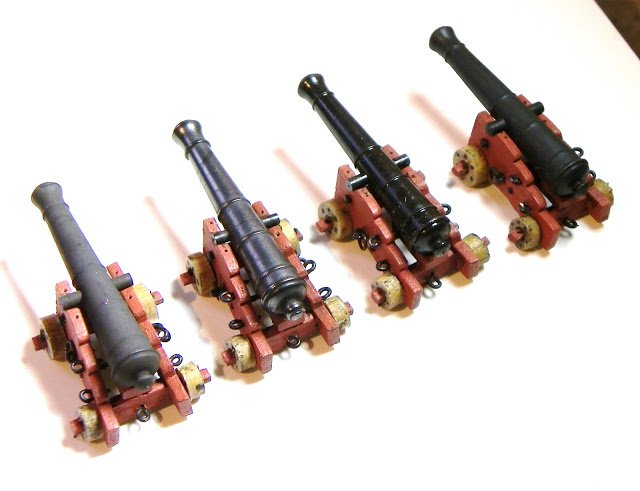
These are the various trial stages I went thro’.
1) Basic blackened gun (paler than in reality)
2) Gun buffed up – not a displeasing result, metallic in appearance but lacks a depth of colour.
3) The gun coated with Carr’s Electroflux, a clear lacquer which is supposed to prevent metal black
patinas from being rubbed away. The result too shiny for my taste.
4) Gun coated with Humbrol mattcote; again no disturbance to the surface in application and a deep
black matt finish resulting. I had originally tried Admiralty matt varnish but being of a milky tone on
application it was difficult to gauge the evenness of the coat, so the mattcote was the option I
decided upon.
I should add perhaps that when I added the GR ciphers to the guns there was an inevitable overspill of ca which needed an acetone scrub.
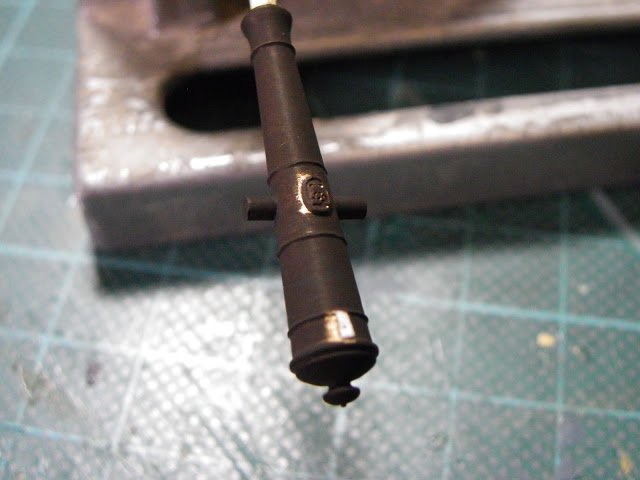
The contamination can be seen here after the first solution dip

Cleaning and re-dipping resolved the problem.
Once blackened I use surgical gloves to handle, and handle as little as possible.
B.E.
-
Crews generally did a little better than that, but the quality of what was dished up was a different matter.
B.E.
-
Hi Daniel, I've looked thro' my reference sources but can't find any specific information on the tray sizes as yet. There is a lot of stuff on the organisation of messes, collection of food, and even that a lot of sailors had their own plates, bowls and cutlery.
Here's a shot of a table in the Gunroom of Victory which may help you to gauge the tray size. Note the pewter plates and drinking vessels.
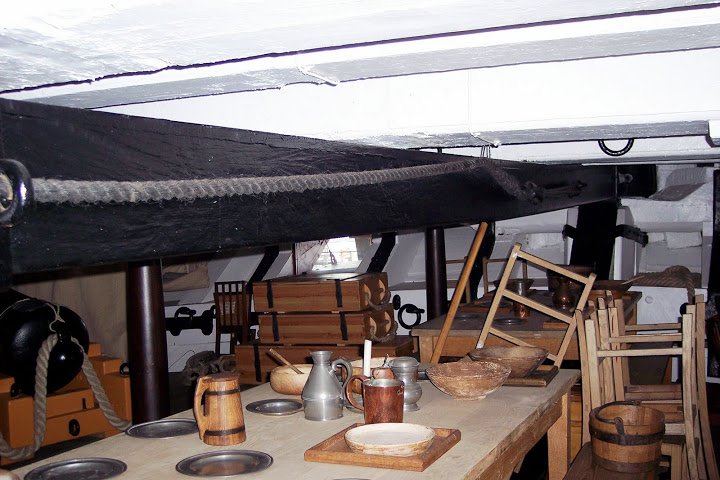
Not sure how authentic the table is, but pehaps the Petty Officers of the gunroom had a better arrangement.
Boudriot isn't of much help in relation to British ships, as the French rank and file ate sitting on the deck out of communal mess bowls, they didn't have individual plates and bowls. The Petty Officers fared somwhat better having tables to sit at.
If I come across anything more I will post it.
M.
-
Hi Lukas, yes I glued the hull halves together before fitting the gun deck.
One or two things you might want to consider before glueing.
Heller did not see fit to provide guide holes along the hull for the gun-port lid lanyards, but it is quite feasible to fit lanyards at this scale so the holes had to be drilled. To this end a small jig is required, I made mine from styrene strip.
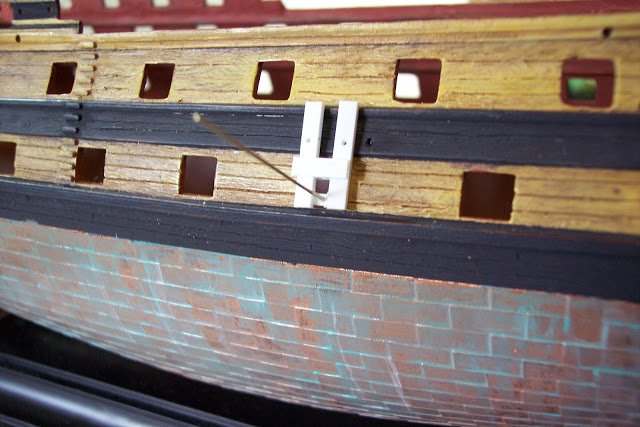
Two strips to fit snugly within the gun-port are glued to the uprights which have guide holes positioned at the right level. It is but a simple job to then to move the jig from port to port drilling thro’ the hull.
The Quarterdeck level bulwark windows have been fitted with glazing bars of 0.25 x 0.5mm styrene strip, and backed by acetate strip.
Gun-port lids were not provided at the Upper deck level although in practice they did have wooden panels (Half ports) that could be fitted from the inside; these had a hole to take the gun muzzle and had a canvas muzzle shaped cover over the outside.
The aftermost gun-port at Upper deck level is interesting, split horizontally, and shaped to fit around the gun muzzle; it is glazed to allow light into the Wardroom.
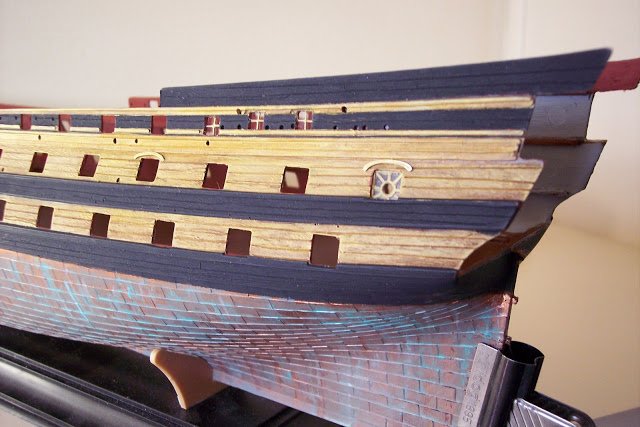
This is not a universal fitting on French Seventy-fours but Boudriot shows it so I also included them on my effort, fashioned from brass, clear acetate and strip styrene – tricky little beasts but we got there in the end.
Over two of the Upper deck gun-ports they did fit Rigols (1st and 4th from the stern) why these two I don’t know but I replicated them with brass wire shaped over a former, and flattened a little on the anvil.
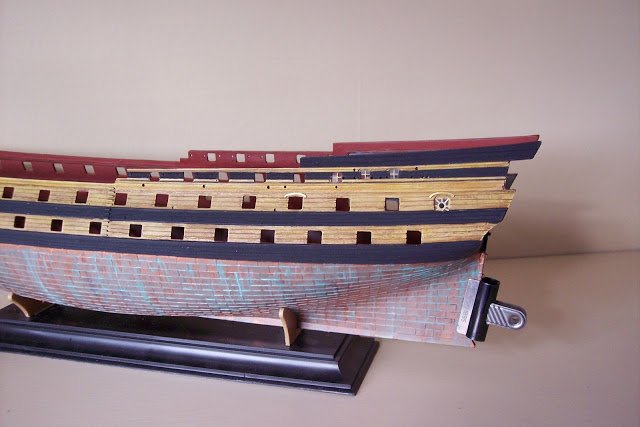
Inside the hull halves the bulwarks were painted, - Red ochre – what else, much easier done before assembly as the tumblehome restricts access.
Holes were also drilled to take the eyebolts for the gun tackle of those cannon visible in the waist, and on the Quarterdeck, an awkward job with the hull assembled.
Heller, for reasons best known to themselves, decided to provide that section of the bow containing the hawse holes as a separate moulding. In retrospect I think it better to glue this in place at the outset, particularly from the point of view of painting.
Cheers,
B.E.
-
I use Carr's Metal Black for Brass
Here's my kit.
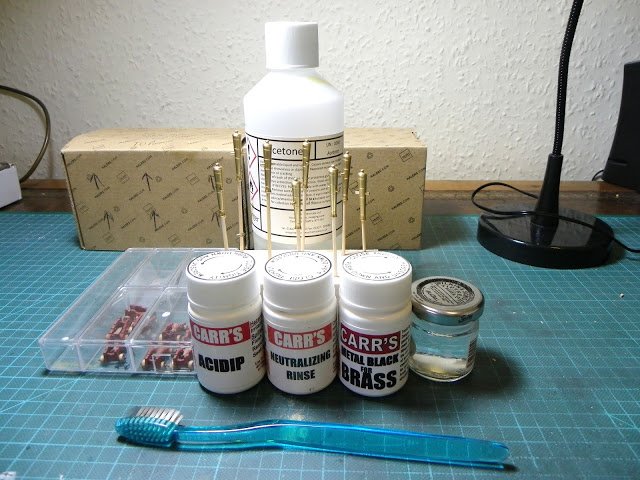
The Blackening solution is diluted by 30% with de-ionised water.
My procedure is:-
A dip in the acid dip, then scrub.
A dip in the neutralising rinse.
Insert in the blackening solution until evenly black, (less than a minute.)
A dip in the de ionised water.
Blow dry with a hairdryer.
Leave for a few hours
Coat with Humbrol mattcote varnish.
This is the result on my Pegasus guns.
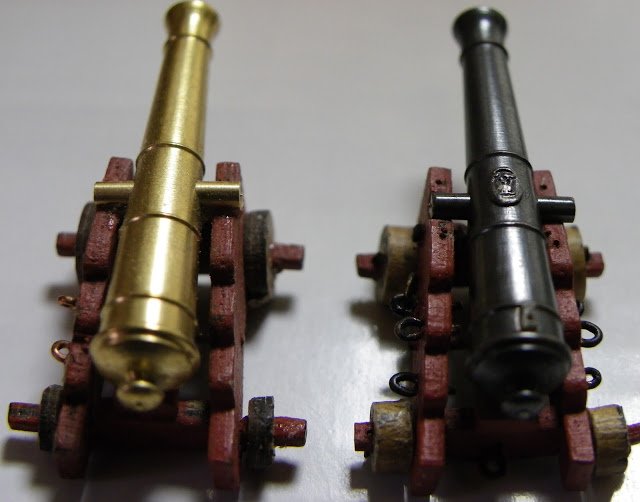
If the finish isn't quite even enough after the solution dip, I rub off and re dip.
Not really had a problem with blackening guns, the secret is I think the thorough clean and scrub before blackening, and the sealing of the surface afterwards.
B.E.
- WackoWolf, Bettina and bundybear1981
-
 3
3
-
-


Hammocks, cranes and covers
in Discussion for a Ship's Deck Furniture, Guns, boats and other Fittings
Posted
Don't know how authentic it is Daniel, but here's how the hammocks are stored on the Trimcomalee in low cranes.
Also regarding your associated query about access to the shrouds..
It doesn't look that difficult for fit young guys, at least on a Frigate.
Regarding the tarring of the canvas covers, I believe this was the case in the early period of use but due to complaints about the stuff getting on the Hammocks and cases the practice was dropped.
According to Carr-Laughton the Theseus at the Nile had her hammock cloths painted to represent an additional deck of guns, and he also refers to the Cambridge of 1824 as certainly having this arrangement.
He also mentions that perhaps Victory when commissioned in 1803 had gunport painted cloths.
Along the waist perhaps as suggested by this Constable sketch drawn of her in the Medway.
M